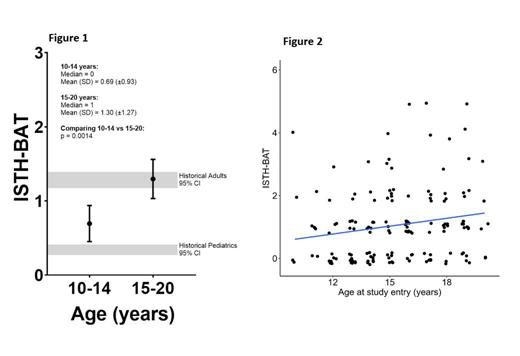Background
Accurate assessment of bleeding severity is critical for timely diagnosis and appropriate management of inherited bleeding disorders. To achieve standardized and reliable evaluation, the International Society on Thrombosis and Haemostasis (ISTH) developed the Bleeding Assessment Tool (BAT). The ISTH-BAT is a comprehensive questionnaire designed to systematically evaluate bleeding symptoms in both children and adults. A crucial aspect of utilizing the ISTH-BAT in clinical practice is determining the normal range of bleeding scores in the general population. Defining this baseline aids in distinguishing abnormal bleeding tendencies from variations within the healthy population. The ISTH-BAT Merging Project established a normal range of BAT scores for children age <18 years as 0-2 and for adult females age ≥18 years as 0-5. However, the normal range of BAT scores for adolescent females remains undetermined. This population is unique because they have undergone the bleeding challenge of menarche but are less likely to have experienced childbirth or multiple surgeries.
Furthermore, while prior studies have shown age-related increases in BAT scores in individuals with von Willebrand Disease, there are limited data on the effect of aging on BAT scores in a healthy adolescent population. This study aims to determine the range of BAT scores in a diverse menstruating adolescent population, compare bleeding scores to published reference ranges from the ISTH-BAT Merging Project and assess potential age-related variations in BAT scores.
Methods
In an ongoing large population study, 10-20 year-old menstruating adolescents presenting for routine care are recruited from primary care clinics across Nationwide Children's Hospital (Columbus, OH, USA). Patients with a prior diagnosis of a bleeding disorder are excluded. The ISTH-BAT is administered by trained study personnel.
Data analyses were completed using nonparametric methods such as Wilcoxon signed-rank or rank sum tests and Spearman's correlation. Means and 95% confidence intervals (CI) were calculated and compared to historical estimates.
Results
In a preliminary analysis of the first 150 participants, the median age was 15 years (IQR: 13-18). Participants represented a diverse range of backgrounds, with 69% of participants identifying as Black/African American, 19% as White, and 12% as other races. 94% identified as non-Hispanic, while 6% identified as Hispanic/Latino.
The mean BAT score was 1.06 (95% CI: 0.87-1.25), with scores ranging from 0-5. The data exhibited a non-normal distribution, with most scores concentrated at 0 or 1, accounting for 72% of the dataset. The mean BAT score is significantly higher than the ISTH-BAT Merging Project pediatric mean score of 0.34 (p<0.0001), but not significantly different from the adult female mean of 1.28 (p=0.99).
When analyzed by age group, participants aged 10-17 years had a mean BAT score of 0.96, significantly higher than the published pediatric mean (p<0.0001) but similar to the published adult mean (p=0.99). Similarly, participants aged 18-20 years had a mean BAT score of 1.33.
To assess if BAT score increased with age, we compared participants aged 10-14 years to adolescents 15-20 years, and identified a small, but significant increase in mean BAT score with age (p=0.001). Participants aged 10-14 years had a mean score of 0.69 (95% CI: 0.45-0.94), falling between the published pediatric and adult means, with no significant difference from either one (p=0.003 and p=0.99, respectively) (Figure 1). However, participants aged 15-20 had a mean BAT score of 1.30 (95% CI: 1.03-1.56), which remained significantly higher than the published pediatric mean (p<0.0001) but still showed no significant difference from the published adult mean (p=0.81).
There was a weak, but statistically significant positive correlation between age and bleeding score, indicating that as age increases, bleeding scores tend to rise (Spearman's correlation r s= 0.21, p=0.001) (Figure 2). Similarly, a weak positive relationship exists between years post-menarche and bleeding score (r s=0.23, p=0.005).
Conclusion
This study provides insight on ISTH-BAT scores in a population of healthy menstruating adolescent females, suggesting that after the onset of menstruation, the adult female bleeding score range may be more suitable for adolescents than the pediatric range.
Disclosures
James:Band/Guardian Therapeutics: Consultancy; Star/Vega Therapeutics: Consultancy; Bayer: Research Funding. O'Brien:Bristol Myers Squibb: Research Funding; AstraZeneca: Consultancy; Pharmacosmos: Honoraria.


This feature is available to Subscribers Only
Sign In or Create an Account Close Modal